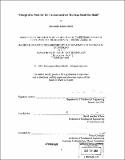| dc.contributor.advisor | David Gordon Wilson. | en_US |
| dc.contributor.author | Sabelli, Alessandra Maria, 1976- | en_US |
| dc.contributor.other | Massachusetts Institute of Technology. Dept. of Mechanical Engineering. | en_US |
| dc.date.accessioned | 2006-05-15T20:29:48Z | |
| dc.date.available | 2006-05-15T20:29:48Z | |
| dc.date.copyright | 2004 | en_US |
| dc.date.issued | 2004 | en_US |
| dc.identifier.uri | http://hdl.handle.net/1721.1/32783 | |
| dc.description | Thesis (S.B.)--Massachusetts Institute of Technology, Dept. of Mechanical Engineering, 2004. | en_US |
| dc.description | Includes bibliographical references (leaf 27). | en_US |
| dc.description.abstract | The project here presented focuses on the development of a harvesting tool for Haiti, a developing country, for the extraction of oil from the seeds of the moringa trees. Moringas have an extraordinarily nutritional potential that can help, at least short-term, to solve problems associated with poor nutrition in the area. Furthermore, moringas naturally prosper in Haiti, making it an accessible and inexpensive resource. A first design is presented in this thesis along with the relevant experimentation and results, and progressive development of possible designs. One of the major concerns regarding the extraction process has been the reabsorption of the oil due to the elastic property of the seeds. This factor is important because a significant percentage of the oil extracted can potentially be reabsorbed, consequently limiting the efficiency of the extraction process. I consequently selected a continuous system that could better ensure a constant pressure, which seems desirable. Moreover, inevitably the design is a compromise between efficiency and cost. Therefore, it was necessary to select a design that could be cheaply produced, limiting also the necessity to produce the whole design from scratch. The final design consists of a meat grinder that ends with a cage shaped as section of a cone, the whole being powered by human pedaling. Fresh seeds are inserted in a cone-shaped feeder, while the cake flows out the smaller end of the cage and oil is collected in a container. This project represents a first step into the development of an extraction tool that maximizes the extraction of oil from moringa seeds, and consequently the consumption of the seeds themselves, not exploited so far. | en_US |
| dc.description.statementofresponsibility | by Alessandra Maria Sabelli. | en_US |
| dc.format.extent | 27 leaves | en_US |
| dc.format.extent | 1273780 bytes | |
| dc.format.extent | 1272293 bytes | |
| dc.format.mimetype | application/pdf | |
| dc.format.mimetype | application/pdf | |
| dc.language.iso | eng | en_US |
| dc.publisher | Massachusetts Institute of Technology | en_US |
| dc.rights | M.I.T. theses are protected by copyright. They may be viewed from this source for any purpose, but reproduction or distribution in any format is prohibited without written permission. See provided URL for inquiries about permission. | en_US |
| dc.rights.uri | http://dspace.mit.edu/handle/1721.1/7582 | |
| dc.subject | Mechanical Engineering. | en_US |
| dc.title | Design of a press for oil extraction from moringa seeds for Haiti | en_US |
| dc.type | Thesis | en_US |
| dc.description.degree | S.B. | en_US |
| dc.contributor.department | Massachusetts Institute of Technology. Department of Mechanical Engineering | |
| dc.identifier.oclc | 57582893 | en_US |
